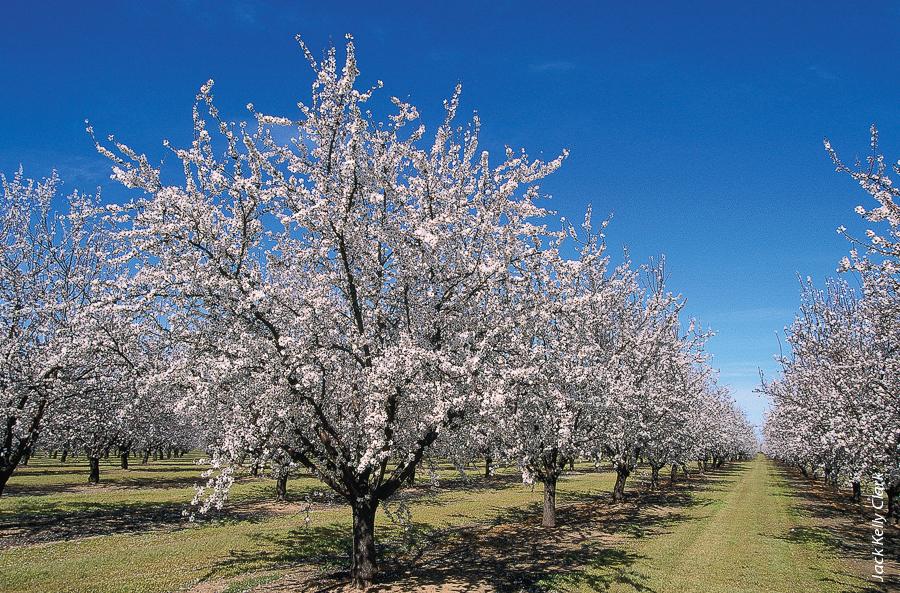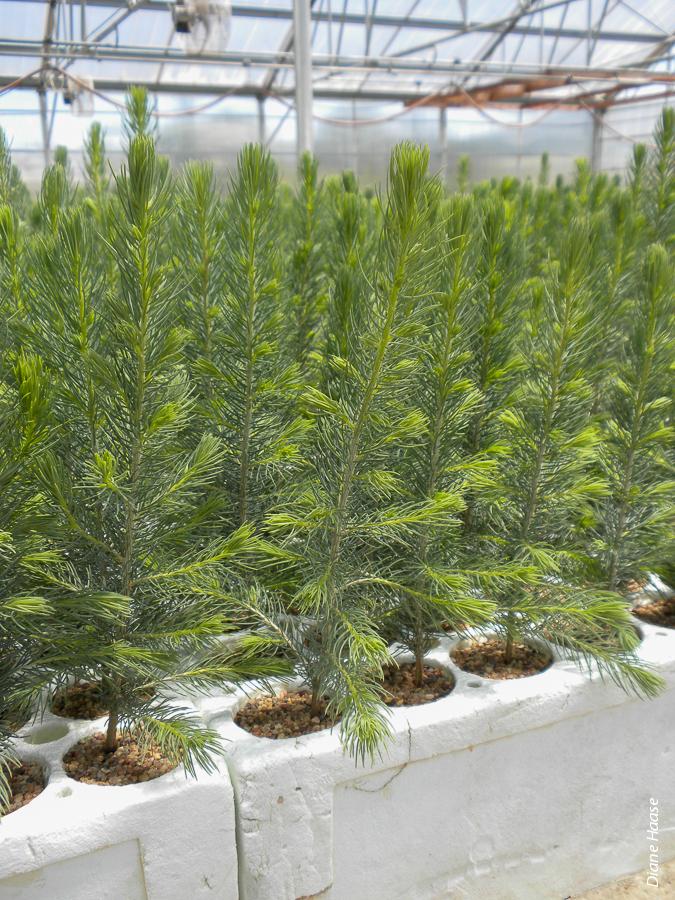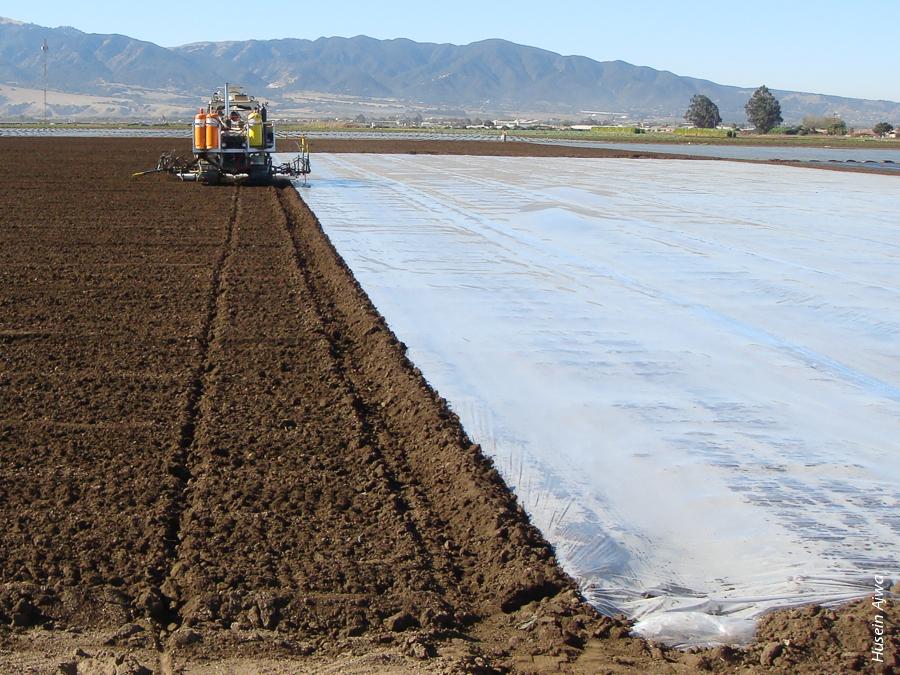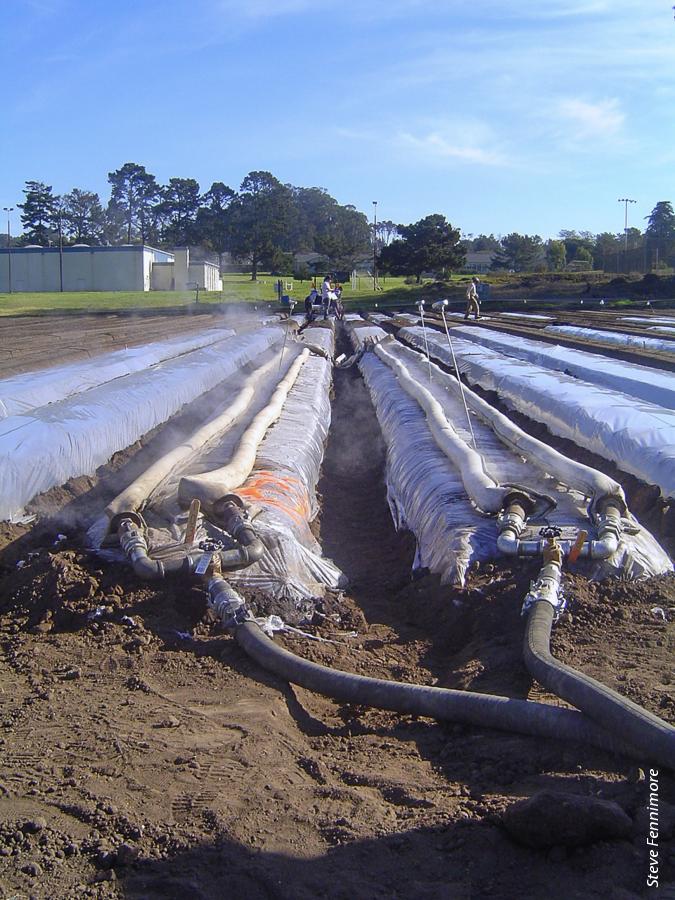All Issues
Specialty crops and methyl bromide alternatives: Taking stock after 7 years
Publication Information
California Agriculture 67(3):123-124. https://doi.org/10.3733/ca.v067n03p123
Published online July 01, 2013
NALT Keywords
Full text
Specialty crop farms and nurseries in California, Oregon and Washington provide local and world markets with abundant fruit, nut and vegetable crops and planting stock. These operations thrive due to dedicated human investment and the availability of precious combinations of soil, climate and water resources. California alone produces 99% of the U.S. almond and walnut crops and 90% of the strawberry crop, and it supplies 99% or more of U.S. almond, raisin, table grape and walnut exports. Combined, California, Oregon and Washington account for roughly 32% of the U.S. floriculture crop value, 44% of the nursery crop value and 78% of the fruit and nut crop value.
Pest-free nursery stock and productive soils are vital to efficient use of land, water, energy and fertilizer resources for specialty crops such as almonds and grapes. Above, an almond orchard in bloom.
We all have a large stake in the availability of specialty crops. Research increasingly documents their benefits to our health. They are a livelihood, directly or indirectly, for many of us. As a society, we have contributed collectively to key infrastructures, such as water resource developments for irrigation and the land-grant college system with its associated teaching, research and extension functions. Indisputably, ample food production, including specialty fruits, nuts and vegetables, is a key measure of national and global security.
Yet specialty crop farming faces serious challenges. Especially in California, urban growth is removing farmland irreversibly. Also, water resources can be allocated away from agriculture, and some specialty crop pest management practices, such as soil fumigation, are requiring intensive regulation to ensure public safety.
In 2006, preplant soil fumigation with methyl bromide, an effective pest management practice used extensively in production of billions of dollars of high-value specialty crops annually, was being phased out due to its contributions to ozone depletion in the stratosphere. Further, the immediate alternatives to methyl bromide, mainly a few other soil fumigants, were on “shaky ground” due to their own environmental challenges.
That year, the U.S. Department of Agriculture (USDA) launched the Pacific Area-Wide Pest Management Program for Integrated Methyl Bromide Alternatives (PAW-MBA). The program drew growers, nursery representatives, regulatory officials and scientists from California, Oregon and Washington to work together as a multidisciplinary team in response to the methyl bromide phase-out. Scientists from the USDA Agricultural Research Service, University of California, California Department of Pesticide Regulation, Oregon State University and Washington State University, along with public and private stakeholders, all were vital to development and implementation of the program.
The PAW-MBA sought to: 1) optimize available “next-best” fumigant alternatives to methyl bromide soil treatments and 2) foster development of non-fumigant alternatives. Specific needs of the targeted production systems (i.e., perennial and annual nursery crops, strawberries, almonds and stone fruits, walnuts and grapes) as well as over-arching environmental challenges (e.g., human health and safety; air, soil and water quality; efficient use of environmental resources) would be accommodated.
In the absence of methyl bromide, specific needs varied among the different production systems. Field nurseries needed alternatives to manage weeds (effective herbicides were not available) and nematodes (certification requires nursery stock to be nematode-free) over 1- to 2-year plant production cycles, and there was little flexibility for non-fumigant alternatives. In contrast, orchardists had less need to control weeds and more pressing needs to manage soilborne pathogen complexes (including but not limited to nematodes) over 15- to 30-year production cycles. Compared to field nurseries, orchard, vineyard and strawberry producers had more flexibility to explore non-fumigant alternatives.
Containerized seedling production in forest nurseries can reduce disease risk by starting seeds in a clean, protected environment such as a greenhouse. Above, Styroblock container production of spruce seedlings in Moscow, ID.
All of the PAW-MBA specialty crop systems shared the imperative to minimize non-target fumigant emissions to the atmosphere. Fumigants are hazardous, volatile, broad-spectrum biocides and are regulated accordingly at federal, state and county levels to keep bystanders safe and minimize environmental impacts. As the project teams formulated plans, soil fumigants were entering a re-registration process that involved extensive reviews of human and environmental risks and refinement of product labels to manage the risks. Also, in parts of California, regulations designed to remediate ground-level ozone unacceptable under the U.S. Clean Air Act were coming to bear on volatile organic compounds, including soil fumigants.
Crop- and emissions-management-centered project teams were formed to implement overall PAW-MBA goals while addressing specific production needs and common environmental concerns of the specialty crop systems. The resulting projects focused on optimizing reduced rates of fumigant alternatives to methyl bromide, testing plastic-tarp-based technologies to improve fumigant performance while reducing fumigant emissions, and examining non-fumigant approaches to soilborne pest management (e.g., use of herbicides, fungicides, soil heating, crop rotation, resistant rootstocks, etc.).
In this edition, California Agriculture presents the first of two special focus sections reporting results of PAW-MBA projects, including alternatives to methyl bromide for almonds and stone fruits ( p. 128 ), strawberries ( p. 139 ), forest nurseries ( p. 153 ), and perennial fruit, nut and ornamental nurseries ( p. 181 ). Fumigant emissions management research was an additional element of some of the crop-oriented projects ( p. 147 ). Future articles will report findings on the use of GPS-controlled spot fumigation technology in orchards; efficacy of fumigant and non-fumigant alternatives in raspberry, sweet potato, and cut flower and ornamental nurseries; and efficacy of alternative fumigants for replanting of walnut orchards and grape vineyards. Although the PAW-MBA program is essentially completed, its outreach continues (for additional overviews of the past and ongoing efforts, visit http://ucanr.org/sites/PAWMBA/ ).
Researchers with the PAW-MBA studied the use of plastic tarp technologies such as totally impermeable film (TIF) to improve fumigant performance while reducing emissions. Above, broadcast shank fumigation under TIF, Salinas, CA.
It became clear from results of most PAW-MBA projects that soil fumigation currently plays a critical role in specialty crop production and efficient use of land, water, energy and fertilizer resources in the process. But what about the future of soil sanitation strategies for specialty crops, given our need to reduce dependence on soil fumigation? This question has recently been considered formally by a scientist-stakeholder group assembled by the California Department of Pesticide Regulation. The group's members recently developed a Non-Fumigant Strawberry Production Action Plan ( http://www.cdpr.ca.gov/docs/pestmgt/strawberry/work_group/action_plan.pdf ), which outlines specific challenges and opportunities for development of non-fumigant production methods. Although the action plan is focused on strawberry production, it is relevant to non-fumigant-based production of other specialty crops. The state plan called for basic and adaptive research, small and large-scale field testing and demonstration, and related educational and infrastructure support. It includes scientific focus areas as diverse as soil microbiology, plant genetics, horticulture, economics and information technology, and recognizes the need for long-term public and private collaboration.
Non-fumigant approaches to managing soilborne pathogens and weeds in strawberry beds include steam treatment, above, in which soil is heated to temperatures higher than 150°F.
The development of viable long-term methyl bromide alternatives remains among many important issues facing specialty crop agriculture and the public it serves. Most of us would prefer to preserve our prime specialty-crop farmland and have access to its healthful produce rather than see it converted irreversibly into competing non-agricultural uses. Yet achieving this preference will require commitment and creativity from us all.
The author wishes to express deep gratitude to all PAW-MBA team and stakeholder members and to the staff of California Agriculture for their dedication and support of the program and this special issue.
California Agriculture journal thanks the faculty chairs for this special collection: Greg Browne, Research Plant Pathologist, USDA Agricultural Research Service (USDA-ARS) and Department of Plant Pathology, UC Davis, and Brad Hanson, Cooperative Extension Specialist, University of California, Davis. We also thank the USDA-ARS Pacific Area-Wide Pest Management Program for Integrated Methyl Bromide Alternatives for helping defray the cost of this issue and the upcoming October-December 2013 edition.








